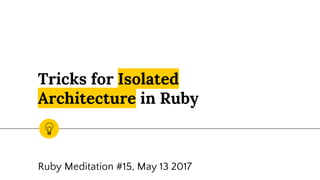
Tricks for Isolated Architecture in Ruby - Sergey Kukunin
- 1. Tricks for Isolated Architecture in Ruby Ruby Meditation #15, May 13 2017
- 2. I am Sergiy And I’ve been searching a silver bullet for a while BTW, my twitter is @sergey_kukunin Hello!
- 3. I work at , Lviv
- 5. The Humble Programmer “we shall be able to design and implement the kind of systems that are now straining our programming ability, at the expense of only a few percent in man-years of what they cost us now, and that besides that, these systems will be virtually free of bugs” by Edsger W. Dijkstra, 1972, http://bit.ly/2pHGbhF
- 6. The Humble Programmer ● intellectually manageable programs ● proof of correctness ● the amount of intellectual effort depends on the program length ● the influence of the tool we are trying to use upon our own thinking habits ● hierarchy
- 7. The Humble Programmer “In computer programming our basic building block has an associated time grain of less than a microsecond, but our program may take hours of computation time. I do not know of any other technology covering a ratio of 1010 or more”
- 8. Two values of software The secondary value of software is its behavior. 1 Defined by Uncle Bob Martin in episode 9 (‘The Single Responsibility Principle’) of his CleanCoders video series
- 9. The primary value of software is that it’s soft. The ability of software to tolerate and facilitate such ongoing change is the primary value of software. 2
- 10. Conclusions ● Programming is complicated ● Programming is risky ● Programming is expensive That’s why we should care about what we write.
- 11. Symptoms of Rotting Design ◉ Rigidity - the tendency for software to be difficult to change ◉ Fragility - the tendency of the software to break in many places every time it is changed ◉ Immobility - the inability to reuse software from other projects or from parts of the same project ◉ Viscosity - two forms: viscosity of the design, and viscosity of the environment http://bit.ly/2rawutr
- 12. Other criterias ◉ Deployability ◉ Developability ◉ Comprehensibility
- 13. Every technique has own advantages and overhead. Sometimes, a technique doesn’t fit. You’re the one who is solely responsible for the code quality of your project. Disclaimer:
- 14. “ The main enemy of software is complexity. To remain maintainable, software should be simple.
- 15. Complexity grows as application grows1
- 16. The biggest impact is made by solution modularity
- 17. Analyze of Sorting algorithms Bubble sort = O(N2 ) When N = 60, N2 = 3600 If we divide an array into two halves we’ll have 2 * (N/2)2 = 2 * (302 ) = 1800
- 20. Single Responsibility Principle ● Definition of responsibility ○ Should have only one reason to change file ● Works on class level as well as on module level ● + Decreases rigidity ● + Necessary step for modularity
- 21. Examples of SRP ● Localization ● Thread handling ● HTML/CSS/JS ● Interactors
- 22. Rely on interface, not on implementation
- 24. The less a module knows about siblings, the more independent it is. Keep encapsulation
- 25. Law of Demeter might indicates that current class knows too much. Does this look better?
- 26. Dependency Inversion Principle ● High-level policy should not be dependent upon low-level detail ● Main trick for decoupling ● + Decreases rigidity ● + Improves modularity/deployability ● + Better testing ● - Lines of code overhead
- 27. How it works: DI
- 28. How it works: DI
- 30. Isn’t this violation of encapsulation?
- 32. IoC 1 ● Separates the application from the main. ● Fixes dependencies order. ● Decouples modules and classes. ● Decreases rigidity of the application.
- 33. Should be iterative, small and often Constant Refactoring
- 34. Boyscout Rule
- 36. Because functions are data First-class functions
- 37. Composability
- 38. Immutability
- 39. First-class tests ● Tests are proof of correctness ● They make you feel safe while refactoring ● Tests drive better design ● Tests should be trustful ● Tests should be fast
- 40. Test-driven development 1. You are not allowed to write any production code unless it is to make a failing unit test pass. 2. You are not allowed to write any more of a unit test than is sufficient to fail; and compilation failures are failures. 3. You are not allowed to write any more production code than is sufficient to pass the one failing unit test.
- 42. “ The only way to keep it simple is to make composition of abstractions
- 43. Simple software is readable software2 We read code even when we write code
- 44. Micro-level ◉ Small classes ◉ Small methods ◉ Intention-revealing methods ◉ Consistent indentation Readability Macro-level ◉ Ubiquitous language ◉ Unified model ◉ Domain-driven design
- 45. DDD separates domain-related code from platform-related 2
- 46. Domain layer: dry-types 1 ● Prevention of illegal state ● Types algebra ● Immutability ● Blazing fast
- 47. Application layer: CQS 1 defines application boundaries: data inside are trusted
- 48. Infrastructure layer 1 ● Independent implementations of 3rd-party services ● The easiest to extract to a gem ● Persistence is here
- 49. UI layer 1 ● An interface for interactive for the application ● HTTP delivery mechanism ● Validation is tied to an interface, not to an entity ● dry-validation
- 50. Persistence layer: ROM 1 ● Adapters ● Relations ● Mappers ● Repositories
- 51. Other advices ◉ Prefer instance methods over class methods ◉ Avoid singletons and global state ◉ Prefer pure functions
- 52. Real experience
- 53. Any questions ? You can find me at ◉ @sergey_kukunin ◉ sergiy@maticinsurance.com Thanks!
